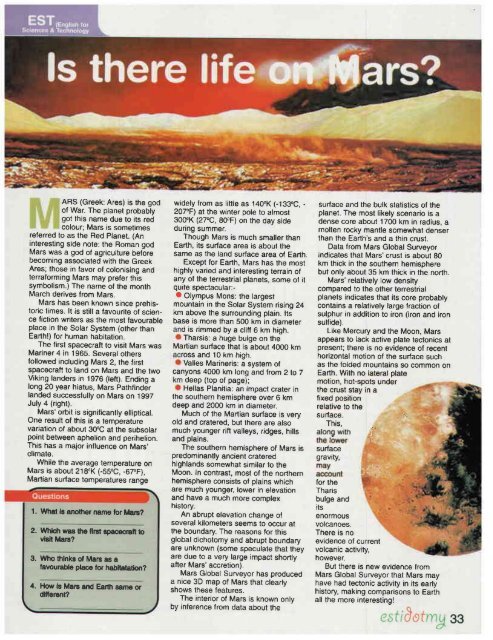Hadiah Nobel - Akademi Sains Malaysia
Hadiah Nobel - Akademi Sains Malaysia
Hadiah Nobel - Akademi Sains Malaysia
You also want an ePaper? Increase the reach of your titles
YUMPU automatically turns print PDFs into web optimized ePapers that Google loves.
ARS (Greek: Ares) is the god<br />
of War. The planet probabty<br />
got this name due to its red<br />
colour; Mars is sometimes<br />
relerred to as the Red Planet. (An<br />
interesting side note: the Roman ood<br />
Mars was a god ol agriculture bel-ore<br />
becoming associated with the Greek<br />
Ares; those in favor ot colonising and<br />
lerralorming Mars may prefer this<br />
symbolism.) The name of the month<br />
March derives from Mars.<br />
Mars has been kno$/n since prehisloric<br />
limes. lt is still a favourite of scignce<br />
ficlion writers as the most lavourable<br />
place in lhe Solar System (other than<br />
Earth!) for human habitation.<br />
The first spacecratt to visit Mars was<br />
Mariner 4 in 1965. Severat others<br />
followed including Mars 2, the first<br />
spacocratt to land on Mars and the two<br />
Viking landers in 1976 (tett). Ending a<br />
long 20 year hiatus, Mars Pathfinder<br />
landed successtully on Mars on 1997<br />
July 4 (right).<br />
Mars' orbit is significan y elliptical.<br />
One result of this is a temDerature<br />
variation of about 3CPC at the subsolar<br />
point between aphelion and perihetion.<br />
This has a maior influence on Mars'<br />
climate.<br />
While the average temp€rature on<br />
Mars is about 2t8oK (-550C, -6ZF),<br />
Marlian surlace temperatures range<br />
l. What ls another nane br Ma|B<br />
2. Whldl u{as thg flr8t sgac€crafr to<br />
vieit Mars<br />
3. Who thlnks ot Mars ae a<br />
fa\ourable plac€ ior habltataton<br />
,f. How ls Mats and Earth sarn€ or<br />
dfielgno<br />
widely from as little as 140oK (-133oC, - surface and the bulk statistics of the<br />
207'F) at the winter pole to almost planet The most likely scenario is a<br />
30CPK (27"C, 80oF) on the day side dense core aboul 1700 km in radius, a<br />
dunng summer.<br />
mollen rocky mantle somewhal denser<br />
Though Mars is much smaller than than the Eanh's and a thin crust.<br />
Earth, its sudace area is about the Dala from Mars Global Surveyor<br />
same as the land surface area ol Earth. indicates that Mars' crust is about 80<br />
Except for Earth, Mars has the most km thick in the southern hemisohere<br />
highly varisd and interesting terrain of but only about 35 km thick in the north.<br />
any of the lerrestrial planets, some ol it Mars' relatively low density<br />
qurte spectacular:-<br />
compared to the other terrestrial<br />
o Olympus Mons: the largest planets indicates that its core probabty<br />
mountain in lhe Solar System rising 24 contains a relatively large traction of<br />
km above lhe surrounding plain. lts sulphur in addition to iron (iron and iron<br />
base is mor€ than 500 km in diameler sulfide).<br />
d is rimmed by a clitf 6 km high. Like Mercury and the Moon, Mars<br />
Tharsis: a huge bulge on the appears to lack active plate tectonics at<br />
Martian surtace that is about 40OO km present; there is no evidence of recenr<br />
ross and 10 km hioh.<br />
horizontal motion ot the surlace sucn<br />
Valles Marineris: i system of as the folded mountains so common on<br />
canyons 4000 km long and from 2 to 7 Earth. Wilh no lateral plate<br />
deep (top ot page);<br />
motion, hot-spots under<br />
Hellas Planitia: an impact crater in the crust stay in a<br />
the southem hemisphere over 6 km fixed position<br />
deep and 2000 km in diameter. relative to the<br />
Much ol the Martian surface is verv surface.<br />
old and cratered, but there are also<br />
much youngeritt valleys,<br />
.<br />
ridges, hills<br />
This,<br />
along with E<br />
and Dlains.<br />
the lower .L<br />
The southern hemisDhere of Mars ts sudace<br />
predominanlly ancient cratered gravity,<br />
highlands somewhat similar to the may {f.+ ,<br />
Moon. In contrast, most of the norlhern accounl '5.-. . :!<br />
hemisphere consists of plains which for the<br />
are much younger, low€r in elevation Tharis<br />
and have a much more comDlex bu196 and<br />
hislory.<br />
its<br />
An abrupt elevation change ol enormous<br />
sev€ral kilometerseems to occur at volcanoes.<br />
the boundary The reasons tor this There is no<br />
global dicholomy and abrupt boundary €vidence of current<br />
are unknown (some speculate that they volcanic activity,<br />
are due to a very large impact shorfly nowever.<br />
atler Mars' accretion).<br />
But there is n€w evidenc€ from<br />
Mars Global Surveyor has produceo Mars Global Surveyor that Mars may<br />
a nice 3D map of Mars that clearly have had tectonic activity in its €arly<br />
sho$,is these features.<br />
history, making comparisons to Earth<br />
The interior of Mars is known onlv all the mor€ interestino!<br />
by inference from data about the<br />
esti8otmg ss

















